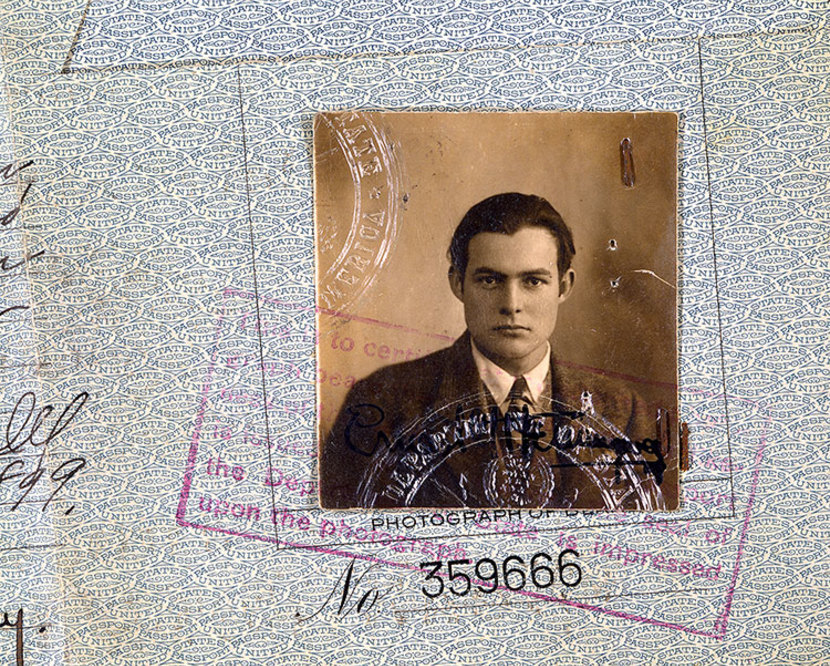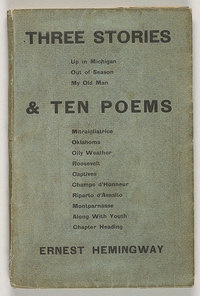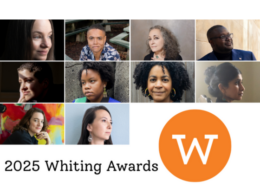Library of America fans are strongly encouraged to visit the Morgan Library and Museum in New York City for the new exhibition Ernest Hemingway: Between Two Wars, a revelatory re-examination of a writer whose outsized fame has often threatened to overshadow everything that’s best about his work.
Organized in partnership with the John F. Kennedy Presidential Library and Museum in Boston, the show is a bonanza of manuscripts and typescripts, first editions, correspondence, and personal mementos. It follows Hemingway from his service as a Red Cross ambulance driver on the Italian front in World War I, where he was badly wounded, to his stint as a war correspondent accompanying Allied troops across France in 1944–45. (Hemingway’s October 1944 dispatch for Collier’s, “How We Came to Paris,” is included in the Library of America anthology Reporting World War II: Volume Two: American Journalism 1944–1946.)

With an emphasis on his Paris years (1921–28) and on the craft of writing, Ernest Hemingway: Between Two Wars is unmistakably meant to supplant memories of Hemingway’s later public persona—the overbearing “Papa,” who starred in ads for Ballantine Ale and Parker 51 pens and who was invariably photographed in the pages of LIFE and Look with a shotgun or fishing rod in hand.
Instead, the exhibition foregrounds the ambitious young talent with avant-garde leanings who adopted Gertrude Stein and Ezra Pound as his mentors soon after arriving in Paris and who claimed he learned how to write from studying Cezanne paintings at the Musée du Luxembourg. These were the years when he set about forging the deceptively simple prose style that would become an inescapable influence on generations of American writers.
Stein’s advice after reading Hemingway’s work for the first time was “Begin over again and concentrate.” The most illuminating aspect of the Morgan exhibition is how keenly he took those words to heart. Manuscript pages on display reveal a determined self-editor who could cut eight pages from the beginning of the story “Indian Camp” in 1924 and two entire chapters from the opening of The Sun Also Rises two years later. These and the other revisions documented in the exhibit make it clear we can all be grateful Hemingway made the choices he did. (Another revelation: the author had to fight to convince his squeamish publishers to keep the term “bed pan” in A Farewell to Arms.)

For Hemingway devotees, there will be a special appeal in seeing physical copies of his rare early publications like 1923’s Three Stories & Ten Poems (printed in an edition of 300) and the first, 1924 version of In Our Time (printed in an edition of 170). Meanwhile, many of the other items on display—such as the ticket stubs from bullfights in Pamplona and Madrid, and an encouraging letter from F. Scott Fitzgerald written on ocean liner stationery—are redolent of an old-fashioned expatriate glamour.
Winding down at the close of World War II, the exhibition sidesteps the saga of Hemingway’s later years, when drinking, depression, and a staggering number of medical problems took their toll on both his writing and his psyche. Yet the Morgan’s curator, Declan Kiely, manages to close on a fascinating forward-looking note.
One of the last items on view is a 1945 letter to Hemingway from J. D. Salinger, written when the latter was recovering from what was then euphemistically known as “combat fatigue” in a U.S. Army hospital in Nuremburg, Germany. The two men had met briefly in Paris just after its liberation in 1944, an encounter Salinger recalls as “the only helpful minutes of the whole business.” It’s increasingly a critical commonplace to read The Catcher in the Rye as a kind of sublimated war novel, but the less obvious parallel is between the stark purity of Hemingway’s early stories and the Zen distillations of Salinger’s short fiction, which date from more than a generation later. By drawing that line, the exhibition hints at some tantalizing potential affinities that can enhance our appreciation of both authors and of American writing over a forty-year period.
Ernest Hemingway: Between Two Wars is on view at the Morgan Library & Museum in New York City through January 31, 2016. Visit themorgan.org for complete exhibition information.



